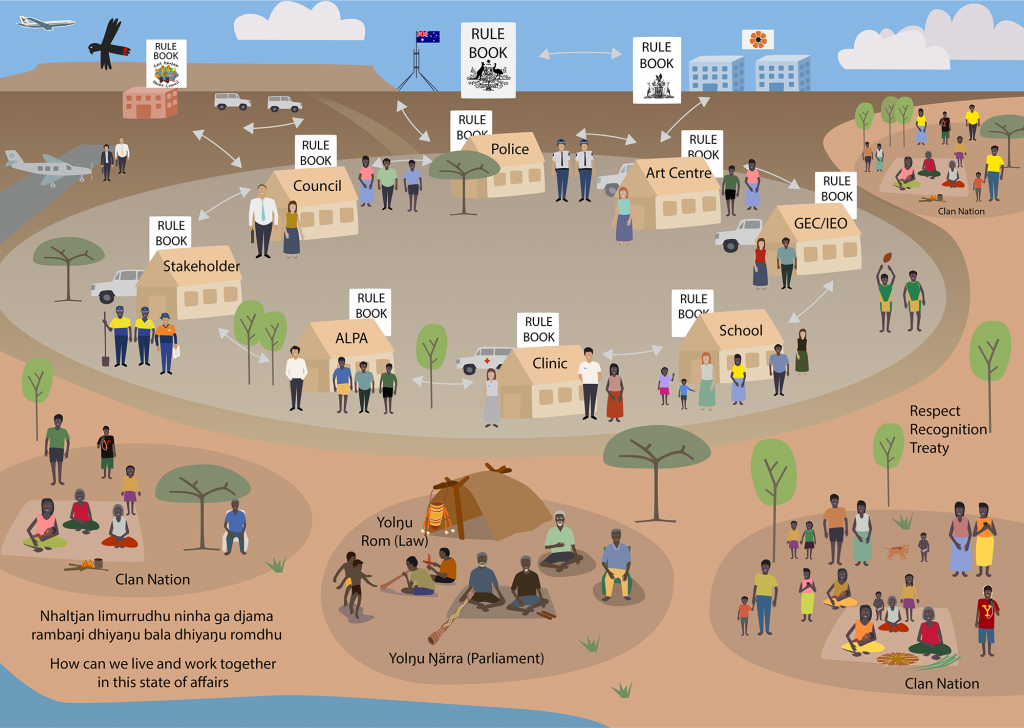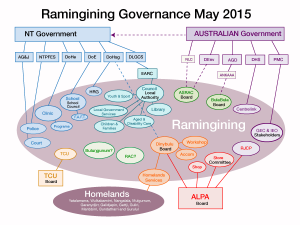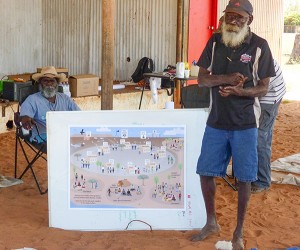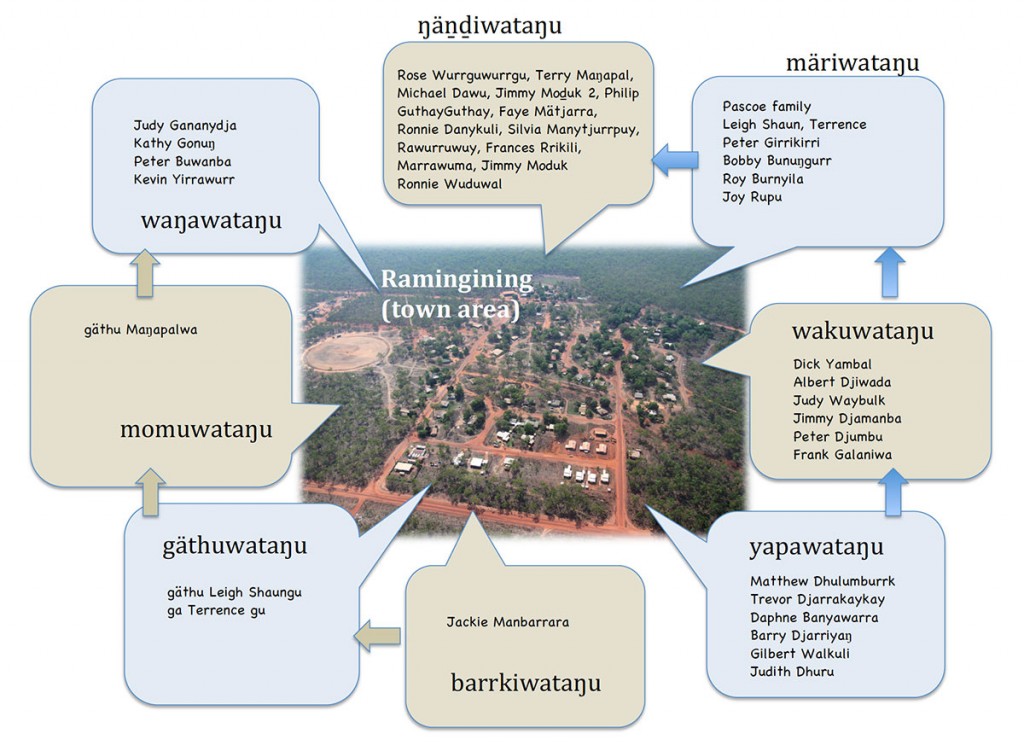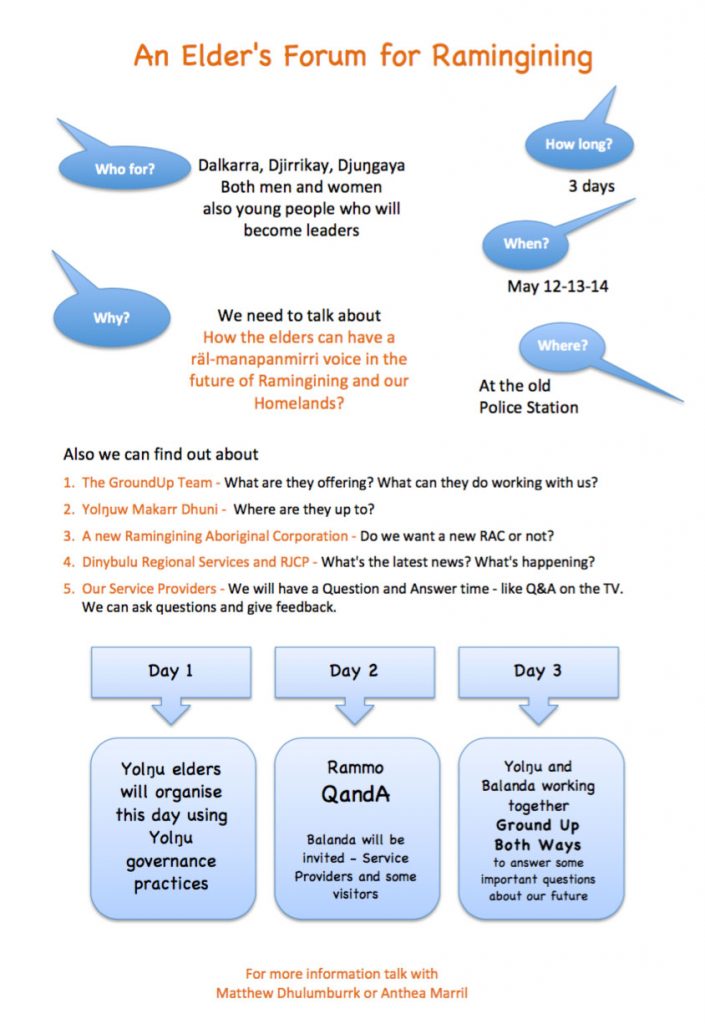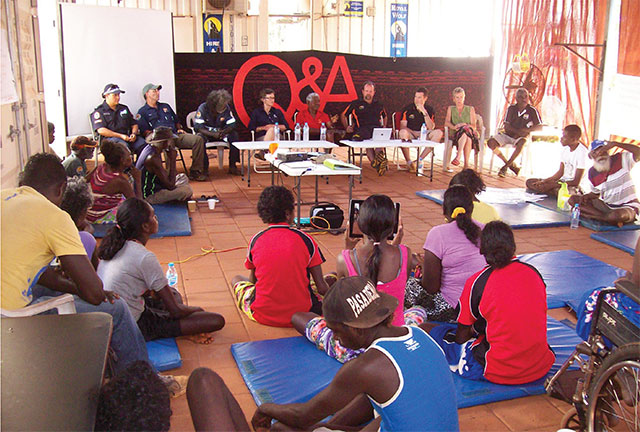Our work in Ramingining built on our presence there in a number of projects over recent years including the Building up Good Supervisors Skills project http://www.bugss.net, and the Building up Skills for Teaching and Learning project http://www.cdu.edu.au/centres/groundup/bustl.html
Anthea had also been a teacher and researcher in the town for many years, so we already had strong relationships with many of the people we would be working with.
We were especially fortunate to have the support of Matthew Dhulumburrk, a Gupapuyŋu elder who is also the chairperson for the Yolŋu Nations Assembly. Matthew worked closely with us, advising and engaging in the both ways teaching and learning which is such an integral part of this project.
Stage 1
As in the other four towns, Stage 1 involved meeting with many of the senior people in the town and Homelands and also Balanda representing key organisations, in order to get a picture of where and how ‘governance’, in the broadest sense, was being played out in Ramingining.
This project was working alongside two other projects. In late 2013 we had conducted a Feasibility Study for a new Aboriginal Corporation in Ramingining. We had also received Federal funding under a project called ‘Walking Together, Working Together’, to support the development of a new corporation.
Stage 2
The first Stage 2 event was a three-day Elder’s Forum, held in May 2014.
Link to Elders Forum and Q&A Newsletter
This event brought together many elders who cared about the future of Ramingining and the challenges it faces in the modern world. Then a small group of elders met two days later to take up the question, ‘Do we want a new Corporation?’ This lead to choosing a steering committee which is currently meeting – with IGLDP support – to build the constitution for a new corporation from the ground up. This means writing a vision statement that matches its vision for Ramingining in the future, and building it on a preamble which sets out the foundations for all Yolŋu institutions, in maḏayin and rom. Link to Steering Committee notes
The IGLDP team was also invited to work with the school council, newly elected and keen to build up its governance understandings and skills. The first workshop was held on 19-20 May. Link to School Council Workshop and Newsletter
Project Reports can be found on the Resources page
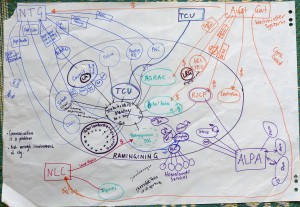 In one visit two facilitators (T and J) and Yolŋu consultant (M) were talking about governance in Ramingining and all the different ‘balanda’ stakeholder groups or ‘bodies’ in Ramingining and their affiliations with government and nongovernment organisations. J began drawing a picture on butchers paper as we talked. Looking at the drawing, M talked about ‘communication’ being a real problem. Not enough involvement of Yolŋu community members in the running of the community through different agencies, Balanda not communicating properly with Yolŋu and vice versa. With issues like school attendance, health and safety etc. most community members don’t understand how agencies have responsibility and how this connects with the community. They don’t know enough about the Australian, NT and local government laws, policies and programs how these are implemented. M pointed out that, ‘There is a current and Yolŋu are caught in the government current which is pulling Yolŋu to their way of learning and doing things. Yolŋu have things. I need to think what I have and what I can do. Yolŋu have land, sea, bush, culture. What I have I can use to make something useful in the modern world’. Later J re-drew it in Word and shared it. This new picture provoked different conversations. ‘Where are Yolŋu leaders in this picture? How do Yolŋu leaders fit into this stakeholder governance picture? No Yolŋu body in the picture. M remembered the days of the ‘Village Council’ in the 1960’s. ‘Maybe we should look at the Village Council again?’ We talked about the VC as a Yolŋu stakeholder group under Yolŋu governance and leadership and operate according to Yolŋu rom (law/protocols/processes). ‘All we would expect is the outside world’s respect’.
In one visit two facilitators (T and J) and Yolŋu consultant (M) were talking about governance in Ramingining and all the different ‘balanda’ stakeholder groups or ‘bodies’ in Ramingining and their affiliations with government and nongovernment organisations. J began drawing a picture on butchers paper as we talked. Looking at the drawing, M talked about ‘communication’ being a real problem. Not enough involvement of Yolŋu community members in the running of the community through different agencies, Balanda not communicating properly with Yolŋu and vice versa. With issues like school attendance, health and safety etc. most community members don’t understand how agencies have responsibility and how this connects with the community. They don’t know enough about the Australian, NT and local government laws, policies and programs how these are implemented. M pointed out that, ‘There is a current and Yolŋu are caught in the government current which is pulling Yolŋu to their way of learning and doing things. Yolŋu have things. I need to think what I have and what I can do. Yolŋu have land, sea, bush, culture. What I have I can use to make something useful in the modern world’. Later J re-drew it in Word and shared it. This new picture provoked different conversations. ‘Where are Yolŋu leaders in this picture? How do Yolŋu leaders fit into this stakeholder governance picture? No Yolŋu body in the picture. M remembered the days of the ‘Village Council’ in the 1960’s. ‘Maybe we should look at the Village Council again?’ We talked about the VC as a Yolŋu stakeholder group under Yolŋu governance and leadership and operate according to Yolŋu rom (law/protocols/processes). ‘All we would expect is the outside world’s respect’.